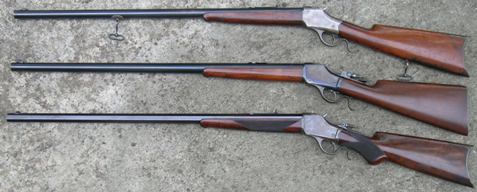Was there a reason they went with such a long barrel? I know longer barrel were common on some large bore single shots but most previous lever guns had shorter barrels. I wouldn’t think that long of barrel would be necessary to burn the powder of that cartridge. Don’t get me wrong I like them and just bought one!
helidriver72 said
Was there a reason they went with such a long barrel? I know longer barrel were common on some large bore single shots but most previous lever guns had shorter barrels. I wouldn’t think that long of barrel would be necessary to burn the powder of that cartridge. Don’t get me wrong I like them and just bought one!
I had always assumed it was more toward wringing out higher velocity of the cartridge. During a similar time frame, Sir Charles went mainly with 28 inch barrels for his .280 Ross cartridge. Sort of interesting how when it came to the .30-06 or .30-03, a 24 inch barrel was standard in the M1895.
As long as we are guessing, I would guess it is due to the Army having the early Krags with 28 inch barrels. Ballistics were basically then known. Yes, I know. The model is an 1895 and the early Army rifle was a model 1896, but likely the Army was working with a prototype at least a year earlier. All pure guessing on my part. I fully suspect the effort was to get the most velocity from the powders then available. Later they could achieve sufficient with shorter barrels for those other cartridges like the .30 Gov’t of 1903, etc. Tim
I completely agree with Tim’s theory about the ballistics of the 30 U.S. (30/40 Krag) cartridge being the reason Winchester chose the 28-inch barrel length for the Model 1895 rifles chambered for that cartridge. The Springfield Armory developed the 30 U.S. cartridge and determined that its optimum ballistics were achieved with a 28-inch barrel.
However, I will add a minor correction in that the early Springfield Krag service rifles were actually Model 1892s versus Model 1896. I own a Model 1892 Springfield Krag rifle (s/n 25766) that was manufactured very early in the year 1895.
Bert
WACA Historian & Board of Director Member #6571L

November 7, 2015
 Offline
OfflineI suspect it had to do with the powders available. They had advanced a bit past Cordite but not much. Today we can select a smokeless powder to optimize burn in a given barrel length. In the early days of smokeless powder the barrel length was probably selected to optimize powder performance. Just a guess, but I know smokeless powder has come a long way since the early days of the 30US.
Mike
Bert, Yeah, I forgot about the 1892 Krag. I forget about a lot anymore. Still as you say, bottom line is trying to get velocity with available powders, I suspect. Besides, taking a side road, a 28 inch barreled, military musket gets you a longer reach with the bayonet! Tim
November 7, 2015
 Offline
Offlinetim tomlinson said
FWIW, the tapered 28 inch barrel on the 1895 looks rather svelte. I am sure you will like it. Unfortunately I tell folks the 1895 model is like fungus–it grows on you! Tim
Agreed, Tim. One reason I bought my latest 1895 from Mark is the cartridge intrigued me and his 1895 had nice wood and a great barrel. I have brass, dies and even a suitable mould. One of the best things about the 1895 is the cartridges found in this model. I’m not a fan of the 1895 but am fascinated when I work the action. How did JMB figure that out with pencil, paper and cardboard?
Mike
I think the 28-inch barrel was specifically designed to be difficult to use in the brush and sprouts Model 1895 owners back in the day were likely very tempted to cut the 28-inch barrel down. I remember having something in a past magazine about Whelen ordering a 30 U.S. 1895 with a heavier and shorter barrel. I think that was in the 1895 book too.
Model 1895 owners back in the day were likely very tempted to cut the 28-inch barrel down. I remember having something in a past magazine about Whelen ordering a 30 U.S. 1895 with a heavier and shorter barrel. I think that was in the 1895 book too.
When we were working on the book, we were very fortunate to use a lot of different gun photos that were submitted by collectors. I was also fortunate to go on the road a few times to take photos of 1895s that ended up in the book. Related to the OP’s other post on the 22-inch barrel, one of those rifles I looked at then was a really nice, pistol-grip, semi-deluxe 30 U.S.”flatside” with a factory Lyman 21, Lyman 6 on the barrel, and a slip-over front sight on the end of the significantly-shortened barrel. I doubt the person that did the cutting put much thought into the rarity of a high-condition, semi-deluxe 1st Model.
1 Guest(s)


 Log In
Log In Members
Members Home
Home

 Add Reply
Add Reply Add Topic
Add Topic





